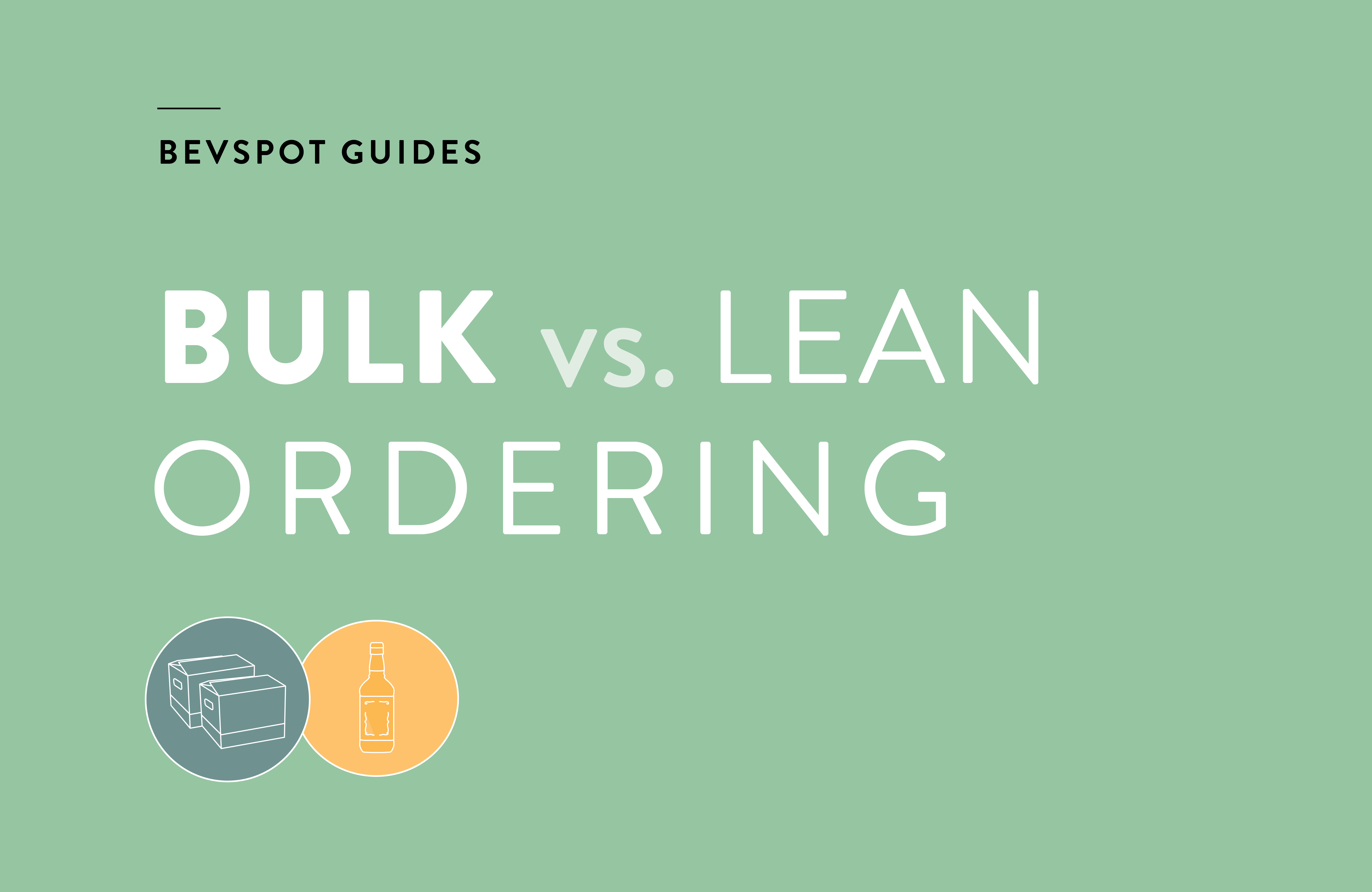


Ordering product should be a careful, well-thought-out process.
It’s important to contemplate how much money you want to spend, how much product you want to order, which product to order, what categories you want to focus on, and how many weeks your purchased product will represent.
When deciding between bulk ordering (purchasing a large amount of product, often based on quantity discounts) and lean ordering (purchasing a small amount of product to reduce sitting inventory), there is no right or wrong answer. Instead, you should consider the benefits and applications of each ordering style, and determine which is best to use in each situation.
To help with your decision process, we made you a guide that explains the pros and cons of each ordering style. If you’re looking for a printable version to pin up in your storeroom, we’ve provided one at the end of this post.
If you aren’t worried about cash flow constraints, you won’t have to worry about spending frugally in order to pay for operation expenses or to save for other investments. More available cash means more flexibility to buy a greater amount of product without worrying about tying up cash.
To incentivize businesses to buy in bulk, distributors often charge breakage fees if you purchase less than a case of product, and they offer promotions and discounts if you place a large order. For example, if you order five cases of Grey Goose, you might get the sixth one free, or if you do a twenty-case drop between Amstel and Heineken, any case you order for the rest of the month might be four dollars off. Taking advantage of deals like these will help you lower your beverage costs and increase your profits, as these savings flow directly to your profitability on each drink sold.
You might receive a discount for ordering in bulk, but you should take a closer look at the size of the discount. If you order six cases just because the distributor is going to throw in an extra bottle, it’s probably not worth the investment, especially if six cases represents over three weeks worth of your inventory. Consider the value of the discount. Is it substantial? Does it benefit your particular establishment?
If your spending is limited, consider ordering lean to avoid tying up your cash. An unnecessary amount of sitting inventory will make your cash unavailable for other important business expenses, such as rent, payroll, taxes and bills. Also, by ordering less product, you’ll have more flexibility to invest your cash elsewhere, such as in projects, equipment and marketing. Although inventory is an important investment, sometimes cash can be more useful if it’s in your pocket rather than sitting on your shelves.
If you’ve previously ordered a product and you have the historical data to prove it will sell, consider ordering a larger amount. Ordering in bulk can help keep your costs down because of distributor specials and discounts. Proven products also pose less risk of getting stuck on the shelves of your storage room.
If you order in bulk, it’s less likely you’ll run out of product. Customers have increasingly high expectations and they certainly don’t like being told you’re out of a product they want to order. If you buy in bulk, you’ll consistently have enough inventory to avoid 86’ing products.
To limit the risk of new products failing to sell, you can order a smaller amount to experiment with. This way, if the product doesn’t sell well, you won’t have a large amount of sitting inventory to deal with. If it ends up being popular, you can order it in bulk the next time you place an order.
This might seem obvious, but when you order products, you have to account for physical space. The amount of storage space you have will limit the amount of sitting inventory you can have. If you have a smaller establishment, you’ll need a lean inventory in order to fit your product. By ordering lean, you also might be able to free up more space for retail displays, customer space, etc.
Not all products last forever. When you order products with an expiration date, such as IPAs and hard cider, consider ordering less product. If you order too much product and don’t go through it by its ‘Enjoy By’ date, you’ll be throwing away money as you pour expired product down the drain.
If you order a product in bulk, when a bottle breaks, you’ll likely have another bottle to replace it. With a cushion of extra product, you can worry less about 86’ing products due to spilled product, broken bottles and theft.
You probably don’t walk around with hundreds of dollars in your wallet. You know if it’s on you, your cash has a higher chance of being lost or stolen. You can think about your sitting inventory in the same way. The bottles on your shelves represent a substantial cash investment. If you purchase less product, there’s less product than can potentially be broken, stolen or spilled.
Distributor representatives like when bars order in bulk—it helps their business and they get more commission. So, if you regularly place large orders, it will help to build a positive relationship with your reps and increase your chances of receiving limited product, exclusive deals, more buyback opportunities, giveaways, etc.
If your distributor has a buyback program, you can order in bulk with more confidence. Distributors often offer to repurchase items to expedite the sale or mitigate concerns. Usually, buybacks exist under set conditions or for a set period of time. When ordering, make sure you’re aware of the certain terms of your distributor’s buyback so you can consider it as a potential option.
As you know, bar inventory can take a while, especially if you have a large sitting inventory to count. It’s simple: the less product you order, the less bottles you have to count at the end of the night and the less time it will take to complete.
Timothy Gallant, the Dining Room Captain at Black Rock Country Club, explains how by using BevSpot, he was able to reduce his sitting inventory and significantly cut down the time it took to count it.
“BevSpot streamlined our inventory process and made it a whole lot easier. I can now do our entire club in the course of four hours, when it used to take me two days!”
When you order product, you should think about how many weeks worth of usage your order amounts for. Calculating weeks’ worth of inventory is a great method for determining inventory efficiency and providing significantly more context to your inventory numbers. It’s recommended that you aim to stock about 2-3 weeks of sitting inventory. When you go to place a order, think about how many weeks’ worth you’re purchasing. The more weeks, the more risk and the more unnecessary cash tied up.
As you can see, there’s a lot to consider when choosing between bulk and lean ordering. It’s important to approach each decision as a unique situation or ordering opportunity, and always consider the benefits and applications of each ordering style.
These kinds of beverage management tasks can be pretty complex, which is why we created BevSpot —to make things more simple.
But, if you still need a little extra help behind the bar, schedule a free chat with one of our bar profitability experts. We’ll take a look at your beverage program, we’ll understand how it works, and then we’ll show you what you can do to run a better bar. All in one, free 10-minute call.
Like what you’ve read?
Get our printable version to take this information on the go.
GET THE FREE GUIDE
Now that you’ve fine-tuned your ordering strategy, see how BevSpot can help streamline the way you order product.
Schedule 15mins to chat with a product specialist
Start a FREE Trial Today! BevSpot offers full product education and account setup for all customers! No card Information needed!
